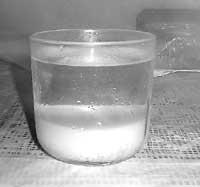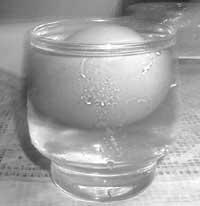What to do for the egg to float

More than once you have heard that to know if the egg is fresh or is past, just put it in a glass full of water. If it is cool it will sink, if it is past it will float. However, that's not what we want to confirm with today's experiment. The question is very different, explain what to do to make the fresh egg float.
You will see that by introducing the egg into a full glass of water it sinks (Figure 1). It does not float. However, you can get the egg to float. To do this, salt, abundant salt, dissolves in a full glass of water (Figure 2). When the salt is dissolved you will reintroduce the egg into the glass and you will see it floating (Figure 3).

We have seen bodies floating in salt water. That is why it is easier to float in the sea than in the river, while in very salty seas, such as the Dead Sea, it is almost impossible to dive. And why? you will wonder. The key is in the beginning of Archimedes. Do you remember? "A body immersed in a liquid suffers an ascending force whose value is equal to the weight of the volume of liquid corresponding to the place in which it is located."

Note that we have highlighted the weight of the volume of liquid that corresponds to the place it occupies. The volume corresponding to the place where the egg completely sinks is the same.
When the salt is melted, the volume of the water does not increase, since the salt molecules are interspersed with those of the water. That is, in the same volume we have the weight of the water plus the weight of the salt. Salt water is denser, that is, the same volume has more weight.
Fresh water of the same volume of the egg has less weight and the egg sinks. The same volume of salt water has more weight than eggs, so it floats.

There is a more complicated experiment than the previous one. Fill half of the glass with water and melt plenty of salt. Once mixed and stopped a little, carefully add fresh water. Try not to mix the water. To do this, we will place a spoon near the bark and help you to pour the water. This time the egg is immersed in the top layer of water, but floats in the bottom layer. As a result, the egg will remain in the center of the vessel without completely sinking (Figure 4).





